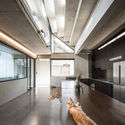.jpg?1575455535)
For the 1957 International Builders Fair, Oscar Niemeyer developed the Interbau Apartment House, a modernist eight-storey building that sits on V-shaped pillars in the city of Berlin. While the building's facade consists of uniform windows and loggias clad with primary-colored mosaics, it is interrupted by enclosed pathways that connect the structure to the external elevator.
Architectural photographer Bahaa Ghoussainy explored the building and highlighted the complementary relationship between its uniform modernity and dynamic suspensions.


.jpg?1575455403)
.jpg?1575455498)
.jpg?1575455479)
.jpg?1575455317)








.jpg?1574409398)

.jpg?1574409412)
.jpg?1574409426)
.jpg?1574409438)



























_3161.jpg?1572863335)
_3161.jpg?1572863335)
_3150.jpg?1572863322)
_3021.jpg?1572863389)
_3066.jpg?1572863162)





















